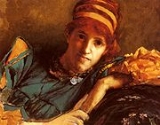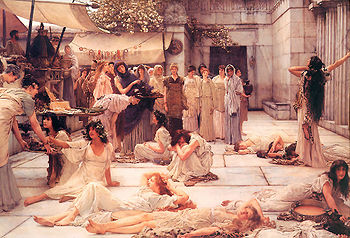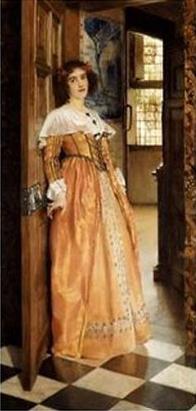
Laura Theresa Alma-Tadema
Encyclopedia
Laura Theresa Alma-Tadema (née
Epps
; 1852 – 15 August 1909 in Hindhead
) was from 1871 the second wife of the painter Lawrence Alma-Tadema
and a painter in her own right.
), her two sisters were also painters (Emily studied under John Brett
, a Pre-Raphaelite, and Ellen under Ford Madox Brown
), whilst Edmund Gosse
and Rowland Hill
were her brothers-in-law. It was at Madox Brown's home that Alma-Tadema first met her in December 1869, when she was aged 17 and he 33. (His first wife had died in May that year.) He fell in love at first sight, and so it was partly her presence in London (and partly the fact that only in England had his work consistently sold) that influenced him into relocating in England rather than elsewhere when forced to leave the continent by the outbreak of the Franco-Prussian War
in July 1870. Arriving in London at the beginning of September 1870 with his small daughters and sister Artje, Alma-Tadema wasted no time in contacting Laura, and it was arranged that he would give her painting lessons. During one of these, he proposed marriage. As he was then thirty-four and Laura was now only eighteen, her father was initially opposed to the idea. Dr Epps finally agreed on the condition that they should wait until they knew each other better. They married in July 1871 and, though this second marriage proved childless, it also proved enduring and happy, with Laura acting as stepmother to her husband's children by his first marriage, Laurence
and Anna
.
 The Paris Salon in 1873 gave Laura her first success in painting, and five years later, at the Paris International Exhibition
The Paris Salon in 1873 gave Laura her first success in painting, and five years later, at the Paris International Exhibition
, she was one of only two English women artists exhibited. Her other venues included the Royal Academy
(from 1873), the Grosvenor Gallery
and others in London. She also had occasional work as an illustrator, particularly for the English Illustrated Magazine
, and was well known as a hostess in their London residences at Regents Park and Grove-end Road. A memorial exhibition of her work was held at the Fine Art Society
in 1910.
in 1879, a bust by Jules Dalou
in 1876, and a portrait by Jules Bastien-Lepage
.
 She specialised in highly sentimental
She specialised in highly sentimental
domestic and genre
scenes of women and children, often in Dutch seventeenth-century
settings and style, like Love's Beginning, Hush-a-bye, The Carol, At the Doorway (c.1898, shown right) and Sunshine. She did paint some classical subjects and landscapes akin to those of her husband, but in general her main influence was 17th century Dutch art
, which was a far less restrained influence in her work than his.
NEE
NEE is a political protest group whose goal was to provide an alternative for voters who are unhappy with all political parties at hand in Belgium, where voting is compulsory.The NEE party was founded in 2005 in Antwerp...
Epps
Epps family
The Epps family was an English family, well known in commerce and medicine. In the second half of the 18th century they had been settled near Ashford, Kent, for some generations, claiming descent from an equerry of Charles II, but were reduced in circumstances, when John Epps rose to prosperity as...
; 1852 – 15 August 1909 in Hindhead
Hindhead
Hindhead is a village in Surrey, England, about 11 miles south-west of Guildford. Neighbouring settlements include Haslemere, Grayshott and Beacon Hill. Hindhead is the highest village in Surrey...
) was from 1871 the second wife of the painter Lawrence Alma-Tadema
Lawrence Alma-Tadema
Lawrence Alma-Tadema, OM, RA was a Dutch painter.Born in Dronrijp, the Netherlands, and trained at the Royal Academy of Antwerp, Belgium, he settled in England in 1870 and spent the rest of his life there...
and a painter in her own right.
Life
A daughter of Dr George Napoleon Epps (who was brother of Dr John EppsJohn Epps
Dr John Epps was best known as a "homoeopathic physician", although his influence was wider as he was involved in "the advancement of commercial, political or religious freedom".-Early years and education:...
), her two sisters were also painters (Emily studied under John Brett
John Brett
John Brett was an artist associated with the Pre-Raphaelite movement , mainly notable for his highly detailed landscapes. Brett was born near Reigate on 8 December 1831, the son of an army vet. In 1851 he began lessons in art with James Duffield Harding, a landscape painter...
, a Pre-Raphaelite, and Ellen under Ford Madox Brown
Ford Madox Brown
Ford Madox Brown was an English painter of moral and historical subjects, notable for his distinctively graphic and often Hogarthian version of the Pre-Raphaelite style. Arguably, his most notable painting was Work...
), whilst Edmund Gosse
Edmund Gosse
Sir Edmund William Gosse CB was an English poet, author and critic; the son of Philip Henry Gosse and Emily Bowes.-Early life:...
and Rowland Hill
Rowland Hill
Rowland Hill may refer to:* Rowland Hill , English Member of Parliament for the City of London* Sir Rowland Hill, 1st Baronet Hill of Hawkstone , built Hawkstone Park follies...
were her brothers-in-law. It was at Madox Brown's home that Alma-Tadema first met her in December 1869, when she was aged 17 and he 33. (His first wife had died in May that year.) He fell in love at first sight, and so it was partly her presence in London (and partly the fact that only in England had his work consistently sold) that influenced him into relocating in England rather than elsewhere when forced to leave the continent by the outbreak of the Franco-Prussian War
Franco-Prussian War
The Franco-Prussian War or Franco-German War, often referred to in France as the 1870 War was a conflict between the Second French Empire and the Kingdom of Prussia. Prussia was aided by the North German Confederation, of which it was a member, and the South German states of Baden, Württemberg and...
in July 1870. Arriving in London at the beginning of September 1870 with his small daughters and sister Artje, Alma-Tadema wasted no time in contacting Laura, and it was arranged that he would give her painting lessons. During one of these, he proposed marriage. As he was then thirty-four and Laura was now only eighteen, her father was initially opposed to the idea. Dr Epps finally agreed on the condition that they should wait until they knew each other better. They married in July 1871 and, though this second marriage proved childless, it also proved enduring and happy, with Laura acting as stepmother to her husband's children by his first marriage, Laurence
Laurence Alma-Tadema
Laurence Alma-Tadema , was an English novelist and poet of the late nineteenth and early twentieth centuries who worked in many genres...
and Anna
Anna Alma-Tadema
Anna Alma-Tadema was a British artist, the second daughter and pupil of the well-known Anglo-Dutch painter Sir Lawrence Alma-Tadema, born Laurens Tadema. Her mother Marie-Pauline Gressin Dumoulin, Laurens' first wife, died when she was two years old. She grew up in London, where her father had...
.

Exposition Universelle (1878)
The third Paris World's Fair, called an Exposition Universelle in French, was held from 1 May through to 10 November 1878. It celebrated the recovery of France after the 1870 Franco-Prussian War.-Construction:...
, she was one of only two English women artists exhibited. Her other venues included the Royal Academy
Royal Academy
The Royal Academy of Arts is an art institution based in Burlington House on Piccadilly, London. The Royal Academy of Arts has a unique position in being an independent, privately funded institution led by eminent artists and architects whose purpose is to promote the creation, enjoyment and...
(from 1873), the Grosvenor Gallery
Grosvenor Gallery
The Grosvenor Gallery was an art gallery in London founded in 1877 by Sir Coutts Lindsay and his wife Blanche. Its first directors were J. Comyns Carr and Charles Hallé...
and others in London. She also had occasional work as an illustrator, particularly for the English Illustrated Magazine
English Illustrated Magazine
The English Illustrated Magazine was a monthly publication that ran for 359 issues between October 1883 and August 1913. Features included travel, topography, and a large amount of fiction and were contributed by writers such as Thomas Hardy, Henry James, Stanley J. Weyman and Max Pemberton...
, and was well known as a hostess in their London residences at Regents Park and Grove-end Road. A memorial exhibition of her work was held at the Fine Art Society
Fine Art Society
The Fine Art Society is an art dealership with two premises, one in New Bond Street, London and the other in Edinburgh . It was formed in 1876...
in 1910.
Depictions
As well as frequently being painted by her husband after their marriage (The Women of Amphissa of 1887 being a notable example), she is also shown in a seated statuette by AmendolaGiovanni Battista Amendola
-Life:He studied in Naples at the Academy of Fine Arts. Much of his work is to be seen in Naples, including a statue of Joachim Murat for the façade of the Royal Palace, a bust of architect Enrico Alvino in the grounds of the Villa Comunale...
in 1879, a bust by Jules Dalou
Jules Dalou
Aimé-Jules Dalou was a French sculptor, recognized as one of the most brilliant virtuosos of nineteenth-century France, admired for his perceptiveness, execution, and unpretentious realism.-Life:...
in 1876, and a portrait by Jules Bastien-Lepage
Jules Bastien-Lepage
Jules Bastien-Lepage , was a French naturalist painter, a style related to the Realist movement.-Life and work:...
.
Style

Sentimentalism (literature)
Sentimentalism , as a literary and political discourse, has occurred much in the literary traditions of all regions in the world, and is central to the traditions of Indian literature, Chinese literature, and Vietnamese literature...
domestic and genre
Genre painting
Genre works, also called genre scenes or genre views, are pictorial representations in any of various media that represent scenes or events from everyday life, such as markets, domestic settings, interiors, parties, inn scenes, and street scenes. Such representations may be realistic, imagined, or...
scenes of women and children, often in Dutch seventeenth-century
Dutch Golden Age
The Golden Age was a period in Dutch history, roughly spanning the 17th century, in which Dutch trade, science, military and art were among the most acclaimed in the world. The first half is characterised by the Eighty Years' War till 1648...
settings and style, like Love's Beginning, Hush-a-bye, The Carol, At the Doorway (c.1898, shown right) and Sunshine. She did paint some classical subjects and landscapes akin to those of her husband, but in general her main influence was 17th century Dutch art
Dutch Golden Age painting
Dutch Golden Age painting is the painting of the Dutch Golden Age, a period in Dutch history generally spanning the 17th century, during and after the later part of the Eighty Years War for Dutch independence. The new Dutch Republic was the most prosperous nation in Europe, and led European trade,...
, which was a far less restrained influence in her work than his.
Works
- Always Welcome, showing a child at her mother's sick-bed, is at the Russell Cotes Museum, BournemouthBournemouthBournemouth is a large coastal resort town in the ceremonial county of Dorset, England. According to the 2001 Census the town has a population of 163,444, making it the largest settlement in Dorset. It is also the largest settlement between Southampton and Plymouth...
- Ruin (and children), an Italianate scene - Russell Cotes, Bournemouth
- Hawking - Medieval - BuryBuryBury is a town in Greater Manchester, England. It lies on the River Irwell, east of Bolton, west-southwest of Rochdale, and north-northwest of the city of Manchester...
Art Gallery - Sweet Industry (1904), showing women weaving - Manchester City Art GalleryManchester Art GalleryManchester Art Gallery is a publicly-owned art gallery in Manchester, England. It was formerly known as Manchester City Art Gallery.The gallery was opened in 1824 and today occupies three buildings, the oldest of which - designed by Sir Charles Barry - is Grade I listed and was originally home to...
. - George EliotGeorge EliotMary Anne Evans , better known by her pen name George Eliot, was an English novelist, journalist and translator, and one of the leading writers of the Victorian era...
(pencil portrait, 1877) - National Portrait Gallery.
External links
- Dictionary of National Biography
- Obituary from The Times in full in the New York Times
- Images of Laura Alma Tadema at the National Portrait Gallery (London)

